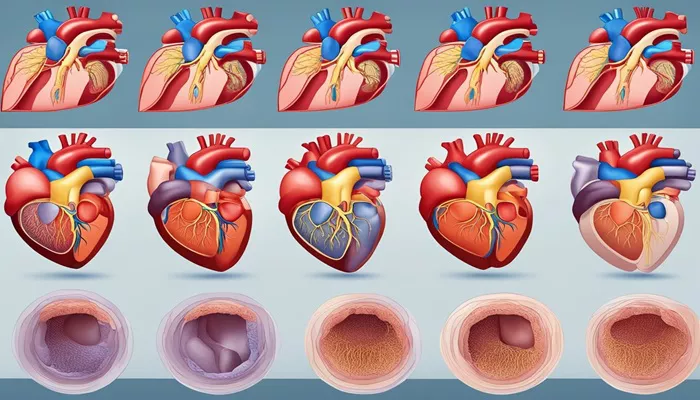Diastolic heart failure, also known as heart failure with preserved ejection fraction (HFpEF), occurs when the heart’s left ventricle becomes stiff and cannot relax properly. This stiffness prevents the heart from filling adequately during the diastolic phase (when the heart muscle relaxes). Although the heart pumps out a normal percentage of blood, the total volume is reduced, leading to symptoms of heart failure.
Unlike systolic heart failure, where the heart’s pumping ability is weakened, diastolic heart failure focuses on filling issues. This condition mainly affects older adults and people with conditions like high blood pressure, obesity, diabetes, and atrial fibrillation.
Recognizing Symptoms of Diastolic Heart Failure
Common Symptoms
Living with diastolic heart failure means you must recognize symptoms early to manage them effectively. Common signs include:
- Shortness of breath, especially during exertion or lying flat
- Fatigue and weakness
- Swelling in the legs, ankles, or abdomen (edema)
- Rapid or irregular heartbeat
- Difficulty exercising or performing daily tasks
When to Seek Medical Attention
If symptoms worsen suddenly, such as increased shortness of breath at rest, chest pain, or fainting, seek immediate medical help. Early intervention can prevent complications.
Medical Management of Diastolic Heart Failure
Medications
While no specific medication cures diastolic heart failure, treatments focus on controlling symptoms and underlying conditions:
Diuretics: Help reduce fluid buildup and swelling by increasing urine output.
Blood pressure medications: Such as ACE inhibitors, ARBs, or beta-blockers, help lower blood pressure and reduce heart workload.
Heart rate control: Medications like beta-blockers or calcium channel blockers help maintain a steady heart rhythm.
Treatment of Underlying Conditions
Effective management requires controlling contributing factors:
Hypertension: Strict blood pressure control reduces heart stress.
Diabetes: Proper blood sugar management limits further heart damage.
Obesity: Weight management through diet and exercise improves heart function.
Atrial Fibrillation: Proper rhythm control and anticoagulation reduce complications.
Lifestyle Adjustments for Living with Diastolic Heart Failure
Dietary Recommendations
A heart-healthy diet supports your condition and overall well-being:
Limit sodium intake: Sodium causes water retention and worsens swelling. Aim for less than 2,000 mg daily or as advised by your doctor.
Eat balanced meals: Include plenty of vegetables, fruits, whole grains, lean protein, and healthy fats.
Limit processed and fried foods: These can increase blood pressure and inflammation.
Monitor fluid intake: Your doctor may recommend limiting fluids to prevent overload.
Exercise and Physical Activity
Regular, moderate exercise improves heart function, muscle strength, and quality of life:
Start slow and gradually increase activity as tolerated.
Walking, cycling, and swimming are good low-impact choices.
Aim for at least 150 minutes of moderate exercise per week, or follow your healthcare provider’s guidance.
Stop and rest if you experience chest pain, dizziness, or severe shortness of breath.
Weight Management
Maintaining a healthy weight reduces heart strain and improves symptoms:
- Work with a dietitian or healthcare provider to set realistic goals
- Combine diet and exercise for best results
- Even modest weight loss can improve heart function and symptoms
Smoking Cessation and Alcohol Use
Smoking damages blood vessels and worsens heart failure. Quitting smoking improves heart health dramatically. Alcohol can also affect heart rhythm and blood pressure, so consume it only in moderation or avoid it altogether.
Monitoring and Managing Symptoms
Daily Monitoring
Track your symptoms and physical changes daily to catch worsening signs early:
- Weigh yourself every morning at the same time; sudden weight gain may indicate fluid retention
- Note any increase in swelling, shortness of breath, or fatigue
- Keep a diary of symptoms and medications to share with your healthcare provider
Regular Medical Check-ups
Consistent follow-up appointments help adjust treatment plans and monitor heart function:
- Periodic echocardiograms to assess heart filling and function
- Blood tests to monitor kidney function, electrolytes, and other parameters
- Adjust medications based on symptoms and test results
Managing Flare-up
If symptoms worsen, early action is key:
Increase diuretic dose temporarily if advised by your doctor.
Rest and reduce physical activity until symptoms improve.
Contact your healthcare provider immediately if symptoms do not improve or worsen rapidly.
Emotional and Psychological Support
Coping with the Diagnosis
Living with a chronic heart condition can be stressful. It’s normal to feel anxiety or depression. Talking to healthcare professionals, counselors, or joining support groups can help.
Importance of Support Networks
Family, friends, and community groups provide emotional support and practical help. Involving loved ones in your care plan can improve outcomes.
Preventing Complications
Recognizing Risks
Diastolic heart failure increases the risk of complications like:
- Atrial fibrillation and other arrhythmias
- Kidney dysfunction
- Stroke
- Hospitalizations due to fluid overload
Prevention Strategies
Effective prevention includes:
- Strict control of blood pressure and blood sugar
- Medication adherence
- Healthy lifestyle habits
- Vaccinations like influenza and pneumonia to prevent infections that can worsen heart failure
When to Consider Advanced Therapies
In some cases, despite best efforts, symptoms persist or worsen. Advanced treatments include:
- Referral to a heart failure specialist
- Device therapy such as pacemakers or defibrillators in select cases
- Clinical trials for new medications
- In very advanced cases, evaluation for heart transplantation or mechanical support may be considered
Conclusion
Living well with diastolic heart failure requires understanding your condition, adhering to treatment, making lifestyle changes, and maintaining close communication with your healthcare team. Early recognition of symptoms, managing underlying diseases, and consistent self-care can greatly improve quality of life.
Related topics:


